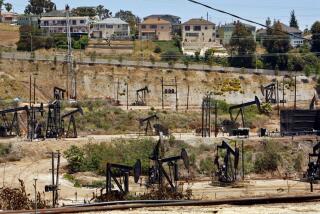Town hopes for jobs tapping California’s huge oil formation
TAFT, Calif. — This two-stoplight town was built on petroleum, and residents here never miss a chance to pay tribute.
A 38-foot monument to wildcatters stands downtown; locals brag it’s the tallest bronze sculpture west of the Mississippi. Every five years, the city throws an “Oildorado” festival. There’s even a beauty pageant in which young women dubbed “the maids of petroleum” vie to be crowned queen.
It’s all an homage to the bustling days when Taft boasted two giant oil fields and Standard Oil Co. of California was headquartered there. The oil giant left in 1968, jobs dried up, and today the Kern County town is saddled with high unemployment and memories of past glory days.
That could be about to change.
Residents are betting on a second boom from oil trapped miles underground in dense rock formations. It’s part of what’s called the Monterey Shale, where oil deposits span 1,750 square miles through Southern and Central California.
“Everyone and their dog would be working if they find that oil,” said Joe Gonzalez, 53, who began toiling in the oil fields around Taft three decades ago as a roustabout. “It’s a huge deal for Taft.”
But a key question is: Could these modern-day wildcatters actually squeeze oil out of the rock?
Some believe technology that can reach previously inaccessible oil means it’s just a matter of time; others are convinced it’s an over-hyped promise.
Oil companies have begun exploring the Monterey Shale underneath towns like Taft that have survived on oil for a century.
More than 15 billion barrels of oil, or two-thirds of the continental United States’ total deep-rock deposits, is estimated to be locked in the Monterey, according to the U.S. Energy Information Administration. Extracting it could mean enormous wealth if oil prices stay around $97 a barrel, and could pump billions of dollars into the local economy.
The much smaller Bakken shale formation in North Dakota has fueled a boom that has driven unemployment in the state down to 3.3%, the nation’s lowest. Taft’s unemployment rate is 13.3%.
But the process is slow going.
“It’s not like the old days where you put a straw into the ground, you get a gusher and you dance around,” said Tupper Hull, spokesman for the Western States Petroleum Assn., an industry lobbying group. “It’s a very complicated process.”
Los Angeles-based Occidental Petroleum and Venoco Inc. of Denver, two of the largest stakeholders in the Monterey, have already drilled exploratory wells.
Federal land leases on the shale are going for $500 per acre at auction, up from $2 to $5 per acre just a few years ago, said Gabriel Garcia of the Bureau of Land Management’s Bakersfield office.
Economists say tapping the shale would be a big boost for the Central Valley, which depends heavily on agriculture and petroleum. By 2015, California could see half a million new jobs and $4.5 billion in oil-related tax revenue, according to a USC study.
“It’s not the muckety-mucks, the higher-ups, who live here,” said Kathy Orrin, executive director of the Taft Chamber of Commerce. “It’s the people in cowboy boots and cowboy hats and Wranglers — and they can make a good living in the oil industry.”
Around noon in Taft, oil workers in dusty coveralls park trucks outside the few lunch spots in town: the OT Cookhouse & Saloon, where black-and-white photos of California’s first gushers line the walls; Jo’s Restaurant, where diners sit below painted oil derricks and fields; and a Tex-Mex place.
Rick McCostlin, 45, thinks jobs could come back and revive Taft. Another oil boom might even attract some of the locals who fled to better-paying gigs in North Dakota’s oil fields.
“We got a lot of people leaving when it gets slow,” said the ponytailed equipment operator, drinking at the OT Cookhouse’s bar.
But the hush-hush world of oil is keeping mum about the Monterey.
With billions of dollars at stake, companies setting up shop are reluctant to reveal any information to competitors. Exploring new oil formations is extremely risky — drilling each exploratory well costs millions of dollars, and most never find anything.
Occidental, Venoco, Chevron and a dozen other oil companies either did not respond to or declined requests for comment.
“The best we have is rumor,” said Taft Mayor Paul Linder, 55, who was born in the town. “I will tell you that rumor in this area about oil usually turns out to be the truth because it’s hard to keep a secret.”
Already, even rumors of that huge oil reserve are bringing new prosperity to the city of 9,400. Best Western submitted plans to build a motel. A housing development with 350 homes built by Hillside Terrace Estates is breaking ground in June. And “numerous” restaurant chains have expressed interest in the small oil town, said City Manager Craig Jones.
Everyone agrees it would be a huge boon to Taft, which was once a tiny railroad stop called Moron before a 1910 gusher in nearby Maricopa flooded the area with oil wealth. The name Moron didn’t carry the same meaning back in the early 1900s that it does today, and city fathers changed it to honor President William Howard Taft when rebuilding the town after a fire.
Oil companies have started hiring in advance. Denver-based Canary, which offers maintenance and equipment to drilling firms, plans to add 10 to 15 employees this year, said Chief Executive Dan Eberhart.
“If I didn’t think the Monterey Shale would blow up, we wouldn’t be here,” he said.
California is the fourth-largest oil producer in the country, behind North Dakota, Texas and Alaska. The push to drill the Monterey picked up in recent years as technology such as horizontal drilling and hydraulic fracturing, known as fracking, began to unlock shale formations in other states.
But doubters — even some residents of hard-beaten Taft — believe it’s a pipe dream.
Some say they’ve heard whispers of the Monterey for decades from parents and grandparents who worked the oil fields before them. They aren’t getting their hopes up.
“I am personally not holding my breath that the Monterey is going to be a big economic boom,” said the executive of a Bakersfield oil company who wished to remain anonymous to preserve a working relationship with a bigger oil firm.
“For whatever reason, the rock is very loath to give up the oil even when they try horizontal drilling, they try fracking, they try a bunch of technology,” he said.
Bob Brackett, an analyst at research firm Sanford C. Bernstein & Co., said California’s earthquake-prone land has stumped drillers and is “unlikely to revolutionize” oil production. His doubts were put down in a report last year titled “The Mystery of the Missing Monterey Shale,” which stirred such a ruckus in the oil industry that he wrote a follow-up report defending his views.
“We don’t expect a Bakken Boom to strike the San Joaquin Valley,” Brackett wrote in a report. “We expect California production to grow only modestly.”
Even Denver billionaire Philip Anschutz, who made huge sums of money selling oil and gas fields in Pennsylvania and North Dakota, has doubts about whether oil can be extracted in “economic amounts.”
“Don’t like it,” he said in a recent interview in Los Angeles. “California isn’t a good place to be making a shale play.”
There are also the environmental concerns that could stymie efforts to drill into the Monterey.
Fracking, which has been used in California for decades, is a controversial process that involves injecting large volumes of chemical-laced water and sand deep into the ground to break apart rock and release oil. Last week, Democrats in California’s Assembly introduced measures to impose a moratorium on fracking. New York has had a similar ban since 2008.
The Center for Biological Diversity and the Sierra Club have sued the California Department of Conservation and Bureau of Land Management for more stringent guidelines. Environmental groups cite worries over water contamination and ruined farmland. A recent study suggested a link between fracking and a magnitude 5.7 earthquake in Oklahoma, the state’s biggest on record.
“The question for California is: Is it worth the risk? Is it worth the damages, the air pollution, the water pollution?” said Kassie Siegel, a lawyer for the Center for Biological Diversity.
In December, Gov. Jerry Brown’s administration released draft regulations for fracking. They would require companies to disclose the chemicals injected into the ground and the locations of wells where they use the procedure.
In Taft, those hungry for the stimulus of the Monterey hope the oil starts flowing.
Carli Tweedy said almost everyone she knows is either employed directly by oil companies or relies on them for business. Born and raised in Taft, the 21-year-old is a technician at a laboratory that does testing for petroleum firms.
“Fracking keeps people in business, so I’m all for it,” she said. “If they could tap into that formation — that would be awesome.”
Times staff writer Marla Dickerson contributed to this report.
More to Read
Inside the business of entertainment
The Wide Shot brings you news, analysis and insights on everything from streaming wars to production — and what it all means for the future.
You may occasionally receive promotional content from the Los Angeles Times.











